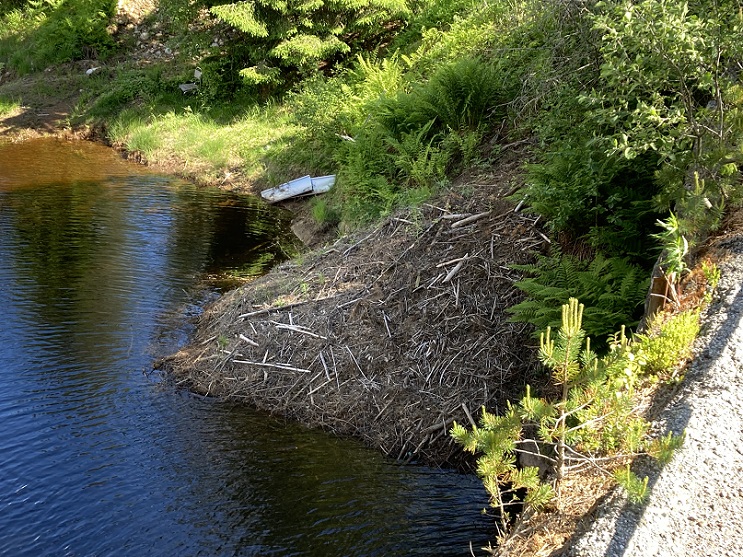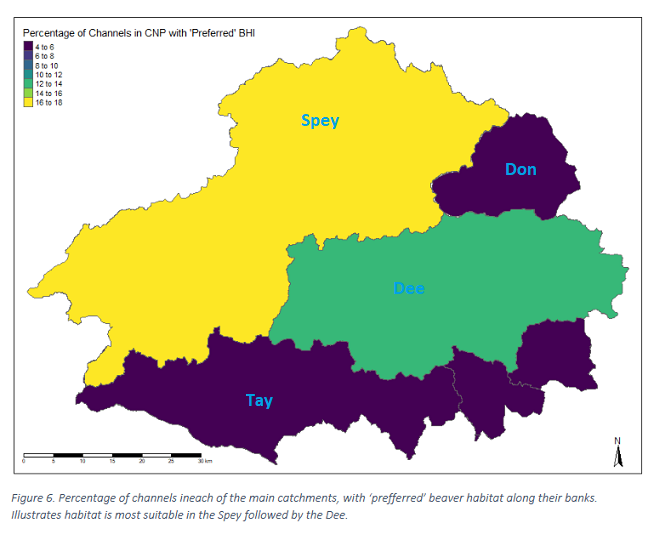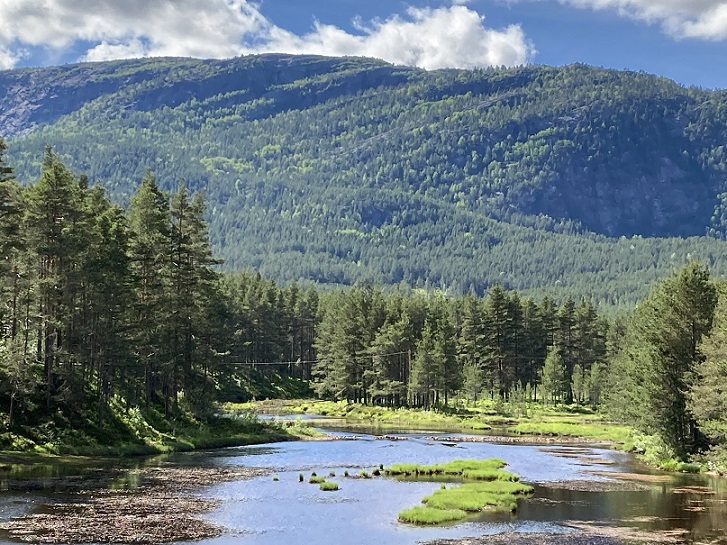
[After publishing this post I was sent a couple of photos by Dave Morris, who had just spent a night in a campervan parked next door to a beaver lodge and the habitat they had created. Duncan Halley, a Scot resident in Norway helped facilitate the translocation of beavers for the Knapdale re-introduction].
At their last Board Meeting on 10th June the Cairngorms National Park Authority (CNPA) agreed (see here for news release) to apply to NatureScot to take a lead role on beaver re-introduction into the National Park with a focus on the Spey catchment. This post explains why this decision is not as positive as it might first appear.
Background
For the last twenty-five years the policy of successive Scottish Governments, driven by landowning interests, has been to make the spread of beavers across Scotland as difficult as possible. While all the research shows beavers are good for biodiversity, creating habitats Scotland now lacks, and help prevent flooding, almost no landowner wants beavers on their patch and most of those that do don’t want to upset their neighbours.
Knapdale was chosen for the official re-introduction programme, precisely because it would be very difficult for beavers to migrate from there to other river systems, and was going nowhere despite years of effort. Meanwhile, by contrast, the beaver population on the Rivers Tay and Earn rapidly spread after unlawful or accidental releases. This and public pressure eventually forced the last SNP Government to protect the species which faced being killed by landowners as it moved into new areas.
At the same time, however, the Scottish Government adopted a policy against any translocations of beavers, arguing that they should be allowed to colonise new areas naturally. This was designed to slow up the spread of beavers and was compounded by the legislation which allowed NatureScot to issue licenses to landowners to kill beavers which they claimed were causing trouble.
Against this background of official obstructionism, CNPA staff to their credit have been looking at the question of re-introductions for some time. In 2013 they presented a paper to their Board (see here) which reported that research had identified the Insh Marshes and Loch Kinnord at Dinnet as “the top two sites in northern Scotland for their suitability for beaver reintroduction”. Nothing, however, then happened (as I explained in a post back in November 2016 see here).
More recently the CNPA set up a beaver-sub group under the Cairngorm Nature Plan which commissioned some research into the likelihood of beavers moving into the National Park naturally. This was quite daring as effectively the CNPA were questioning whether beavers could re-colonise the Cairngorms as per Scottish Government policy at the time. The report concluded that natural colonisation was highly unlikely, partly because of the lack of woodland/suitable habitats in the upper reaches of catchments of the River Tay and the River Isla, both of which have beavers, but also because of hydro dams.
However, by the time the report (see here) was published in April the new SNP Government had been forced into a policy U-turn as a result of the public outcry at the large numbers of beavers being killed by landowners under license. The new policy was that beavers could be translocated within Scotland after all (some had been sent down to England) and soon afterwards a number of beavers which.otherwise would have been shot were moved to Argaty near Doune (see here). Meantime NatureScot announced they were developing a National Beaver Strategy which is due to be published at the end of the month.
The paper (see here) to the recent CNPA board meeting reported that NatureScot’s strategy will identify two or three priority areas for beaver release in Scotland, based on river catchments, and that these would include the Spey and Beauly river basins. The decision to use the catchment of the River Spey catchment for beaver translocations therefore appears to have been taken by NatureScot before the CNPA Board considered the issue.
The primary purpose of the Board was to decide how far the CNPA should be involved in the translocations; whether it should take an observational role, an enabling role or a leadership role in the translocation of beavers to the Spey. It has come to something that this question was even asked. Our National Park Authorities have a statutory duty to promote nature conservation and sustainability and beaver re-introduction is a no brainer. If our National Parks cannot automatically take a lead when it comes to issues such as beaver re-introductions what are they for?
So what was going on?
Part of the issue I believe is the strength of landowning interests on the CNPA Board is such that there would have been uproar if staff had taken a lead without their permission.
It goes further than that, however. The Board paper failed to make any mention of the fact that the area around Dinnet in the Dee catchment had previously been identified as one of the two best places in northern Scotland for beaver release. Moreover, the research report published in April, in considering the possibility of natural beaver migration into the National Park, had considered the availability of suitable beaver habitats within the National Park:

While the Spey catchment came out top,with 16-18% of channels having preferred beaver habitat, the Dee is not far behind in having plenty of suitable habitat for beavers. Again the Board paper made no mention of this despite what beavers could do to help address the climate and nature emergencies and prevent a recurrence of the terrible floods that partially destroyed Ballater in 2015.

In my view this silence about the potential of beavers on the Dee is not unconnected to the strength of traditional sporting landowners there, led by the Royal Family. Last year Chris Packham issued a public challenge to the Royal Family to take a lead and reintroduce beavers at Balmoral (see here). Since then there has been absolute silence. The interesting question is what lobbying, both direct or indirect, has been brought to bear on CNPA staff on this issue. Prince Charles has only to nod his disapproval for public authorities, and the leaders of the many wildlife organisations of which he is patron, to roll over.
As an example of the indirect way in which the Royal Family protects sporting interests, I have twice emailed Richard Gledson (4th and 25th May), the factor at Balmoral, to ask whether the royal estate supported the production of the Grampian Moorland Group leaflet that made scurrilous claims about the CNPA plan (see here). I have had no answer. Why not, if Balmoral has nothing to hide?
In truth, NatureScot’s beaver strategy, which will attempt to focus beaver reintroduction into a few catchments, appears to be yet another attempt to try and prevent their spread across Scotland. And implicit in the CNPA’s decision to take a lead on translocations on Speyside is that beavers should be prevented from colonising the rivers Dee and Don as long as possible.
There are a couple of hopes as far as the CNPA is concerned. The first is that at least they have been considering and discussing beavers, unlike the Loch Lomond and Trossachs National Park Authority which has maintained an almost complete silence despite beavers spreading into the National Park up the Rivers Tay, Earn and Forth. The second is that having omitted beaver translocation from the first draft of the National Park Partnership Plan (NPPP) last year, the June Board meeting agreed that by 2027 they would “Facilitate beaver translocation in the Cairngorms National Park”. This leaves it open to them to promote beaver releases in other catchments than the Spey.
The wider picture – why is conservation so much more difficult than development?
It is worth contrasting the precautionary approach the Scottish Government has taken to beaver re-introductions, despite all the research which shows it is a good think, with the development free for all that has applied to run of river hydro schemes, despite an almost complete absence of research about their impacts. Both beavers and hydros developments dam rivers but do so in very different ways. Beavers create permeable dams which allow wildlife through and slow the flow of water downstream whereas hydro dams do the opposite. Public policy is far more concerned about beavers gnawing down a few trees than it is with the destructive impacts caused by the construction of hydro schemes. If the Scottish Government and our public authorities should have been taking a precautionary approach to anything, it should have been to hydro schemes but instead conservation is tangled in bureaucracy.
While part of the explanation for the development free for all comes down to the prevailing ideology that all development is good, much of the explanation for the very different way government responds to development and conservation in the countryside comes down to the power of landowners. The policy assumption is that landowners should be allowed to manage their land as they wish – so there are few controls on developments or on how landowners use their land for their own enjoyment – and that can only be overrided in the interests of people and the planet in exceptional circumstances.
CNPA staff encapsulated the issues in another reference to beavers in the NPPP:
“The regulatory framework around releases of species is not consistent at present, meaning that a licence is not required to release pheasants and partridges, but is required to release beaver or red squirrels.”
In other words the current law allows traditional sporting estates to pursue their interests without any control while blocking conservation initiatives. In a more rational and fairer world the CNPA would now be working to translocate beavers to all the river catchments within the National Park – there are plenty still being killed under license – rather than just one.

The simple answer is that it is not in fact a real national park at all and a whole raft of private sectional vested interests have to be appeased/assuaged.
Beavers are already present in the Beauly system
Sorry, I should have said that in the post – it reinforces the fact that the translocation programme is completely unambitious and is moving beavers to places they are already found. Nick
A very good resume of one example of the barriers to nature conservation and biodiversity in our National Parks. At least CNPA is making a start (albeit a very slow one) to support the re-introduction of beavers into the Cairngorms National Park. The problem, as you point out Nick, is that the estate landowners are still far too powerful in their lobbying of CNPA and the Scottish Government. The feeling, from someone living in the Cairngorms is that CNPA keep on attempting to partner with the estate land owners, but do not spend anywhere near enough time trying to partner with environmental groups such as BSCG (Badenoch & Strathspey Conservation Group). It’s a far too one sided attempt at partnership by CNPA.
There continues to be evidence that CNPA gives lip service to the main aims of the National Park, especially the important addition at the end of the 4 aims, “if there is conflict between the first aim [To conserve and enhance the natural and cultural heritage of the area] and any of the others, greater weight is given to the first aim. Just one example of this is the disappearance of this important caveat from parts of the CNPA website which list the 4 aims – e.g. https://cairngorms.co.uk/working-together/authority/about/. This is a very concerning change to the CNPA website which everyone needs to challenge CNPA to correct…..and then live up to applying this important caveat to the Park’s 4 aims.
We need to take a very close look at the role played by Scottish Government officials in boosting landowner representation on the NatureScot and National Park Boards. Who is directing that agenda? Are Scottish Ministers content that it is happening?